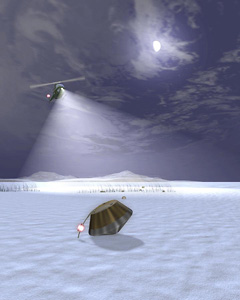Stardust was a United States space probe designed to collect material from a comet and return it to Earth for study. Scientists believe that comets preserve leftover ice, rock, and dust from the solar system’s formation. By analyzing samples gathered by Stardust, they hope to learn more about the solar system’s composition and history. The National Aeronautics and Space Administration (NASA) launched Stardust on Feb. 7, 1999.

Stardust carried a device called a collector built to capture dust and other small particles spewing from the comet. The collector consisted of a grid of cells filled with an extremely lightweight solid called an aerogel. Mission planners chose the aerogel because its low density would enable the fast-moving particles to penetrate deep into the cells before coming to rest. A denser material might have stopped the particles too abruptly, causing them to melt or even vaporize on impact.

On Jan. 2, 2004, Stardust flew within 147 miles (236 kilometers) of the nucleus (solid core) of Comet Wild << vihlt >> 2. During the flyby, the craft’s collector captured thousands of particles from the comet’s coma. The coma is a cloud of dust and gas surrounding the nucleus. The craft also took detailed images of the nucleus of Wild 2, revealing a landscape marked by slender peaks, broad mesas (flat-topped hills), and deep depressions. These features appeared remarkably sturdy, suggesting that the nucleus has a relatively strong, solid surface. Many scientists had thought that the nucleus might consist of loose rubble held together by gravity alone. As Stardust passed through the coma, its instruments detected several distinct jets of dust and gas coming from small, active regions on the surface of the nucleus.

After the flyby of Wild 2, Stardust headed back to Earth to release a capsule containing the collected samples. The capsule parachuted to the ground on Jan. 15, 2006, landing in Utah’s Great Salt Lake Desert. Scientists were surprised to discover that the samples included material that had formed in a hot environment near the sun or other stars. Wild 2 had formed beyond the orbit of Neptune, but the gravitational pull of Jupiter brought it into the inner solar system in 1974. The discovery suggested that material had been mixed throughout the solar system early in its history. The samples also included organic (carbon-containing) molecules, some of which serve as the chemical building blocks of life.
In July 2007, NASA announced a mission to use Stardust to revisit the comet Tempel 1 in 2011. The NASA craft Deep Impact had previously visited Tempel 1 in 2005, when it intentionally sent a probe crashing into the comet’s nucleus. The New Exploration of Tempel 1 (NExT) mission, the first effort to revisit a comet, was designed also to give scientists their first look at how a comet nucleus changes after it passes near the sun. In March 2011, shortly after Stardust’s second encounter with Tempel 1, the spacecraft sent its last transmission to Earth, concluding 12 years of service.
Loading the player...Stardust-NExT flyby
